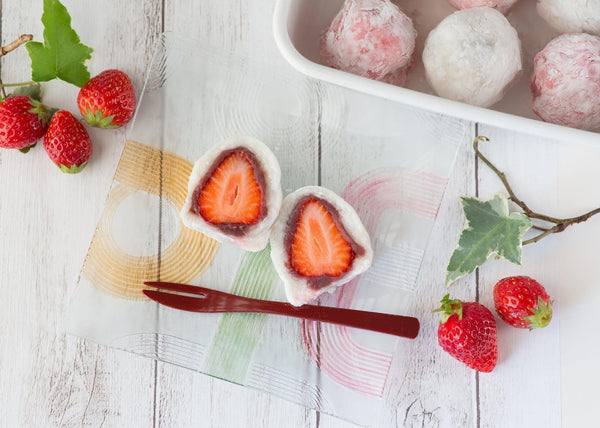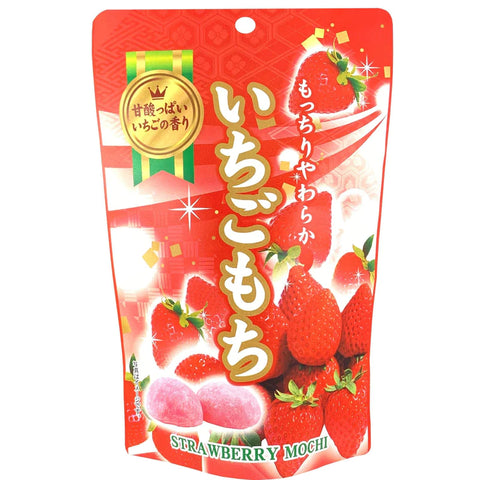
Jump to:
Are you a fan of Japanese sweets?
If so, you know that Japan produces some of the finest confectionery to be found anywhere. From traditional “Wagashi” sweet creations to Japanese twists on European pastry, it’s hard to beat Japan when it comes to the world of desserts.
Among the many stars a sweet tooth will encounter in Japan, Daifuku emerges as a real masterpiece. Daifuku (or Daifuku Mochi) is a type of Wagashi that is made from glutinous rice. It is often filled with traditional Wagashi favorites such as red bean paste, though we’ll see that indeed many flavors and textures are offered in this range. Daifuku is enjoyed by people of all ages in Japan, and has become a popular item for visitors to sample and even take home as a souvenir.
In this edition of the Japanese Taste blog, we will explore the origins and distinctions of Daifuku and then unravel its delightful variations. From the iconic strawberry (Ichigo Daifuku) to the lesser-known treasures like Shio Daifuku, coffee Daifuku and beyond, this Japanese delight is sure to please.
History Of Daifuku In Japan
Daifuku's lineage began centuries ago, rooted in the simplicity of glutinous rice and the desire to create something sweet and extraordinary.
The name itself, "Daifuku," carries a profound meaning, signifying not just a sweet treat but a harbinger of good luck.
Historically, Daifuku was a confection associated with auspicious occasions and celebrations. Its evolution mirrors the dynamic culinary landscape of Japan, adapting to the changing tastes and preferences of each subsequent era.
From humble beginnings to becoming a treat enjoyed year-round, Daifuku remains a favorite among Japanese people who love their sweets.
Daifuku Mochi vs Traditional Mochi

Continuing with a closer look at Daifuku, let’s address a common misconception – the distinction between Daifuku and regular mochi. While both involve glutinous rice, each embodies distinct characteristics in their preparation and presentation.
Mochi, in its pure form, refers to pounded glutinous rice molded into shapes, often round or square. It serves as a blank canvas, awaiting the addition of flavors and fillings.
Daifuku, on the other hand, takes mochi to new heights. It involves the artful creation of mochi enfolding sweet fillings, transforming a simple rice cake into a luscious and satisfying confection.
Daifuku, one might say, is the result of the culinary artistry that emerges when mochi meets creativity.
Daifuku vs Dango

As we’ve already seen, when it comes to “Wagashi” Japanese sweets, the lines between delicacies can sometimes blur.
Daifuku and dango, both featuring glutinous rice, present an interesting juxtaposition of form and preparation.
Dango typically manifests as rice flour dumplings skewered on sticks, each bite revealing the chewy texture of rice flour on the exterior. Unlike Daifuku, which encapsulates sweet fillings within a mochi shell, dango highlights the simplicity of rice flour.
Both share a love for glutinous rice, yet each offers a distinct experience – Daifuku with its harmonious blend of mochi and fillings, and dango with its skewered, bite-sized delights.
Different Types of Daifuku
With history and comparisons addressed, let's journey deeper into the world of Daifuku, specifically looking at the many variations with which one is presented when opting for Daifuku as the sweet of choice.
Ichigo Daifuku (Fruit Daifuku)

Picture a whole strawberry nestled within a tender mochi embrace, surrounded by sweet red bean paste. Ichigo Daifuku, with its balance of tartness and sweetness, exemplifies the union of fruit and confection.
The simplicity of a ripe strawberry makes this Daifuku variant a veritable celebration of summer's bounty. The choice of using a whole strawberry not only adds a burst of freshness but infuses the confection with a balance of sweet and tart notes. The glutinous rice flour, with its tender and chewy texture, cradles the jewel-like strawberry, while the sweet red bean paste adds another layer of complexity.
For those eager to recreate strawberry Daifuku at home, we've curated a step-by-step recipe to guide you through the art of crafting Ichigo Daifuku:
How to Make Ichigo Daifuku at Home
Creating your own Ichigo Daifuku is a culinary endeavor that will connect you with the heart of a Japanese confectionery masterpiece.
Shio Daifuku

A departure from the conventional, Shio Daifuku introduces a somewhat surprising element – salt.
The marriage of saltiness and sweetness creates a unique flavor profile, challenging the palate in the most delightful way. Prepare your taste buds for an unconventional experience with Shio Daifuku, where the addition of salt introduces a savory element to the sweetness. This variant challenges the traditional notion of sugary confections, offering a nuanced interplay between salty and sweet.
Coffee Daifuku

For those who revel in the aromatic embrace of coffee, this Daifuku variant involves coffee-infused mochi.
The bitter notes of coffee meld seamlessly with the sweet filling, offering a sophisticated treat for coffee enthusiasts and sweet lovers alike. If you’re both of those, well, these are the Daifuku you’re looking for!. Catering to the discerning palate of coffee aficionados, Coffee Daifuku offers a sensory journey that begins with the aromatic allure of coffee and culminates in the marriage of mochi and filling.
Matcha Daifuku

Japanese tea culture plays a big role in matcha Daifuku, where vibrant green hues and the distinctive flavor of matcha transform this confection into something quite special.
This is the happy result when Japanese tea artistry mixes with Daifuku. The bitter notes of matcha complement the sweetness of the mochi and filling, creating a balanced and sophisticated treat.
Yomogi Daifuku

Yomogi, or Japanese mugwort, lends its subtle herbal notes to mochi, creating a Daifuku with a nuanced and earthy flavor. The aromatic essence of Yomogi adds a layer of complexity to a classic treat, giving a subtle earthiness to the mochi.
Custard (Cream) Daifuku

Indulgence takes center stage with custard Daifuku. The velvety richness of custard filling adds decadence to the chewy mochi exterior, creating a heavenly experience for those with a penchant for creamy delights. The pillowy filling elevates this confection, while the juxtaposition of the smooth custard against the chewy mochi creates a satisfying texture.
Ume Daifuku

Ume, or plum, introduces a delightful tartness to Daifuku. The sweet and tangy plum filling is a refreshing twist, making Ume Daifuku a unique and palate-cleansing treat. This variant showcases the versatility of Daifuku, marrying the sweetness of the mochi with the vibrant flavors of the plum. It’s a unique and invigorating Daifuku that we highly recommend you try when visiting Japan.
Exploring these variations unveils the vast array of possibilities among Daifuku. Can’t decide which is right for you? Start sampling, and let your taste buds take action!
Where To Find Daifuku In Japan
If you’re traveling in Tokyo, Kyoto or elsewhere on the popular tourist routes in Japan, you’re sure to see Daifuku in many forms as you visit the most popular sights and districts.
Not all Daifuku are created equal, of course. If you see more locals in a Daifuku shop, it’s more likely to be good. That’s why we recommend avoiding the obvious stands that are too close to the touristy places – they’re fine, but you can do better by searching Google Maps to find local Daifuku shops (or ask your hotel or Japanese friends what’s best!).
You’ll also likely find Daifuku for sale in the airport shops before you go home, so if you’re looking for some last-minute souvenirs or mementos, Daifuku is a good option.
Daifuku Available On Japanese Taste
Craving some Daifuku Mochi at home? We’ve got some for you!
Shinshu Shine Muscat Cream Filled Daifuku Mochi 9 Pieces
If you’re a daifuku lover and want to be able to indulge in the real deal anytime at home, then these Shine Muscat Daifuku are calling your name! This daifuku snack is triple-layered three and has three different flavors and textures that come from mochi, white bean paste, and cream. The best part is that you can enjoy a sensory taste and textural experience along with the flavor of real shine muscat grapes.

[callout-1]
Seiki Bite Sized Daifuku Mochi Snack Amaou Strawberry Flavor 130g
While these daifuku snacks do not contain a filling, they are packed with really amaou strawberry flavor! Amaou strawberries, also known as the king of strawberries in Japan, are juicy, sweet, and are bursting with flavor! The texture of this daifuku snack is also much softer than traditional mochi. We also offer these bite-sized daifuku treats in melon, persimmon, and matcha, so you can try them in all your favorite flavors!

[callout-2]
Yaokin Choco Daifuku Chocolate Filled Marshmallow Snack 148g
This snack is a unique twist on daifuku, as it is comprised of marshmallows instead of mochi and is filled with chocolate. If you’ve never tried daifuku or mochi before, this is the perfect daifuku snack to start with.

[callout-3]
Nihonbashi Kabou Jelly Filled Mochi Snack Fujiya Nectar Peach Flavor 100g
This is another great snack option for daifuku lovers who can’t make it to Japan. This peach-flavored mochi snack contains 3 layers - a chewy mochi outer layer, a stretchy marshmallow layer, and a juicy peach center. They’re packed with real peach flavor and make the perfect daifuku snack. We also carry similar snacks in calpis and milky flavors.

[callout-4]
Daifuku: A Celebration Of Flavor & Tradition
Wrapping up this exploration of Daifuku and its myriad variations, we can see that this Japanese confectionery transcends the boundaries of simple sweetness. Daifuku is a hallmark of the evolving landscape of Japanese sweets, a standout in a diverse array of flavors and textures.
Whether you find yourself captivated by the iconic Ichigo Daifuku or enticed by the unconventional allure of shio, coffee or Yomogi Daifuku, each variant offers a different twist. The artistry behind Daifuku lies not only in its taste but also in its ability to encapsulate the essence of joy, fortune and creativity.
Have you tried Daifuku before? Which one is your favorite? Let us know in the comments section below. Happy (and sweet) culinary adventures!


0 comments